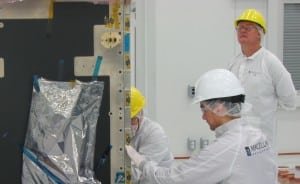Latest News

Magellan Engineers at work in the Advanced Satellite Integration Facility (ASIF). Photo: Magellan Aerospace.
[Via Satellite 04-24-2015] Canadian aerospace company Magellan Aerospace recently unveiled its new Advanced Satellite Integration Facility (ASIF) in partnership with the University of Manitoba that the company believes will foster a productive relationship between academia and industry. The Winnipeg-based 6,000-square-foot facility aims to expand not only Magellan’s own satellite operations, but also the presence of the nearby university in the satellite-engineering field.
To date, Magellan has designed and launched three satellites, including Scisat, a SmallSat the Canadian Space Agency (CSA) launched more than 10 years ago to study ozone depletion in the atmosphere. The company also developed Cassiope, which was launched just over a year ago to conduct space environment research as well as advanced telecommunications technology demonstrations. Through those previous projects, Magellan has often employed engineers and technicians at the university to help the company find a better way of doing things.
“We had a long relationship with the University of Manitoba and previously did a number of study contracts with them on various materials or different types of research studies. We both wanted to have a more formal arrangement in place,” Don Boitson, vice president and general manager of Magellan Aerospace, told Via Satellite.
When the opportunity arose to come to research, develop, construct and test new satellite components at the ASIF, both agreed the partnership would help expand Canada’s presence in the satellite field. The aims of the facility are two-fold, according to Boitson, the first being to allow engineering students to gain a hands-on, industry-based education.
“Through the partnership, university students are able to lead the increase in technology in the state sector in Western Canada. They’ll be involved in their own Industrial Research Chair and looking at various opportunities and experiments that they can carry out in this advanced facility embedded in our company,” said Boitson. “The goals for us are to enhance the experience of the university program and curriculum to enable more real-time or science work for the engineers.”
One such experiment that students are currently conducting at the facility is a project to find innovative solutions for Micrometeorites and Orbital Debris (MMOD) shield protection, which aims to asses and develop ways to protect satellites and the International Space Station (ISS) from space junk. It is independent programs such as this, as well as those that Magellan will conduct in conjunction with research students, that the company believes will make all the difference as far as expanding Canada’s space presence.
“Ultimately, whether those engineers go on to work at Magellan or work wherever in the space or manufacturing sector, we think it’s a very positive experience on that aspect as far as the learning of the students,” said Boitson.
The second aim of the facility, however, is to allow for Magellan to grow its own capabilities, particularly in the way of new contracts the company has established with its major customer for satellite programs and buses, the CSA.
The new ASIF is large enough to accommodate up to three satellites at various stages of assembly, with ceilings high enough to accommodate crane-lifting requirements. It’s also an International Standard Organization (ISO) class 8 cleanroom facility that will allow the company to conduct operations in the particular manufacturing environment necessary to satisfy the requirements of the future satellite programs initiated by the Government of Canada.
Magellan is currently working on a number of small and medium study contracts, but the largest involves a $110 million contract awarded in 2013 to design and build three Radarsat Constellation Mission (RCM) satellites for the CSA. The CSA’s RCM mission aims to provide twenty-four-hour-a-day C-band data to augment and extend the information that Canadian users rely on for maritime surveillance, disaster management and ecosystem monitoring. The constellation is set to launch in 2018, and thanks to the new facility Magellan will have the space they need to build it.
“We would not have been able to manufacture the three radar constellation mission satellite buses without this new facility. The size of the spacecraft and the quantity of buses that we’re manufacturing require a larger facility than we previously had for carrying out this kind of work,” said Boitson. “That’s the bulk of the work that is going to be taking place at the Advanced Satellite Integration Facility.”
Going forward, Boitson sees the company focusing mainly on SmallSats to satisfy the needs of the CSA. He hinted that Magellan is also exploring business opportunities outside of the country.
“We’re looking at expanding our market internationally with either the bus, the components or the associated engineering,” said Boitson. And the ASIF may just allow research students to lead the way to the global market. “We’re hoping that, with this program, the University of Manitoba establishes itself as a leader in aerospace engineering and enable us as industry to grow to meet the opportunities in the market. That’s why we invested in it and that’s what we’re both counting on for the future.”
Get the latest Via Satellite news!
Subscribe Now